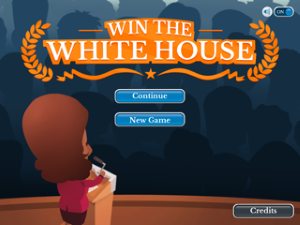
Find more great Horn Book content at these links:
Recommended books: reviews and themed booklists
App and e-book reviews
Movie reviews
Event news and recaps
Events calendar
Win the White House app review
If you’ve gotten anywhere near the news in the past, oh, fifteen months, you know one thing: running for president is complicated.
 If you’ve gotten anywhere near the news in the past, oh, fifteen months, you know one thing: running for president is complicated. It requires careful planning and strategic skill. Ever wondered if you’ve got what it takes? Find out with Win the White House (iCivics, 2011 with update July 2016; iOS, Android, and web).
If you’ve gotten anywhere near the news in the past, oh, fifteen months, you know one thing: running for president is complicated. It requires careful planning and strategic skill. Ever wondered if you’ve got what it takes? Find out with Win the White House (iCivics, 2011 with update July 2016; iOS, Android, and web).First, choose an age level: elementary, middle, or high school+. Even the elementary level is pretty sophisticated; the only difference among the levels seems to be the number of campaign issues on the table, and perhaps the level of potential controversy — for instance, only the highest level includes “Women’s Right to Choose” and “Support Gay Rights.”
Select an avatar, a name, a home state, a party, and a slogan. You can choose to run in the primaries as a tutorial, or skip that step. Either way, you’ll find yourself at a debate. Choose issues to discuss; an exclamation point indicates a “hot issue” that especially matters to voters, such as federal education funding and government transparency. Then, choose from a selection of possible reasons for your position (generated by the app based on your party choice). There are right and wrong answers, but in many cases these are fairly obvious — the other choices are often either outlandish (no, “transparency” has nothing to do with glass buildings) or pulled from questions about other issues. You can also choose to include a “maverick” issue in your platform by supporting a position generally championed by the other party.
After your platform is settled — and you choose your running mate and meet your opponent — it’s time to take the campaign on the road. You have ten weeks to garner all the electoral votes you can; at the beginning of each round, or week, the app will show you how many electoral votes you have, and which states you’ve gained or lost, according to polling data. You can poll states, and view data about any states you’ve already polled (the app starts you off with a few), to see what support and fundraising resources are available to you.


Then, using polling data on which issues matter to people in a given state, select “Appearance” or “Media” to give speeches or run positive or negative ads based on specific issues. (Captions show what the ads are supposed to be saying, but their dramatic voiceovers, which sound something like “buh-buh, buh buh buh,” are especially reminiscent of real political ads.) Newscasters will comment via speech bubbles on how well you and your opponent are doing, and perhaps admonish you for focusing on irrelevant issues. Inez, your campaign manager, also pops up frequently to give you instructions or advice. Rousing music plays in the background throughout.

This is an involved app, one that requires a significant time commitment. The integrated animations can be lengthy, and you can skip some but not all of them. You also can’t start a new game while you’re in the middle of a campaign, so if you want to try a different level or change something about your character, you’re out of luck (I guess that’s true of real elections, too). But if you’re up for the challenge, this is an effective and engaging way to get thinking about the many factors involved in real-life elections. On a more basic level, it’s also a strategy game with plenty of suspense.
…just in case you weren’t in enough suspense over the real election.
Available for iPad (requires iOS 6.0 or later) and Android devices (requires Android 4.4 and up); free. Recommended for intermediate users and up.

RELATED
RECOMMENDED
ALREADY A SUBSCRIBER? LOG IN
We are currently offering this content for free. Sign up now to activate your personal profile, where you can save articles for future viewing.







Add Comment :-
Be the first reader to comment.
Comment Policy:
Comment should not be empty !!!